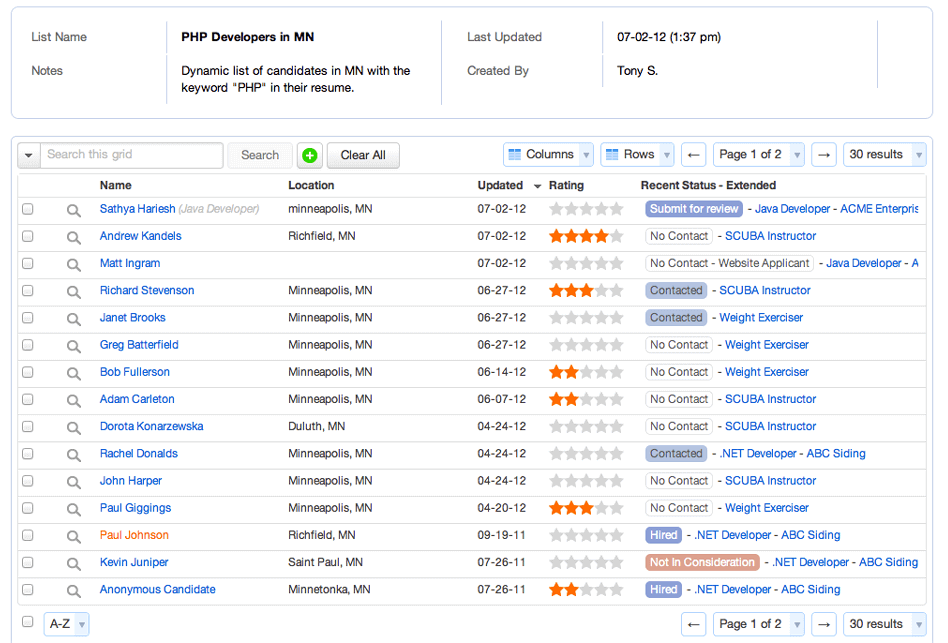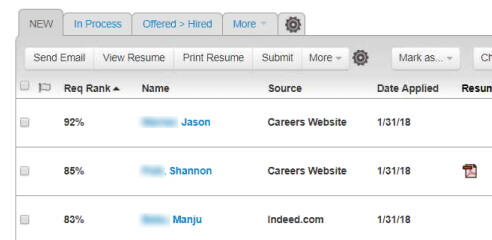In Which Capacity Do You Know the Aplicant
What do you know about applicant tracking systems?
If y'all remember the start obstacle to getting a task interview is a recruiter'south judgment, yous're non seeing the whole film. 99% of Fortune 500 companies and a growing number of small and mid-sized businesses filter resumes through an applicant tracking organisation (ATS) before someone takes a look… if they ever do.
Larn how ATS work, what they do to your resume, and how to trounce ATS and then that your resume gets seen past the human decision makers who schedule job interviews.
1. What are applicant tracking systems?
Applicant tracking arrangement software provides recruiting and hiring tools for companies. Among other functions, these systems collect and sort thousands of resumes.
Read full commodity: What is an applicant tracking organisation?
When yous apply for a job online, your resume isn't typically going directly to a recruiter or hiring managing director. It's first being processed past an ATS. Whether that human recruiter e'er sees your resume could depend on how well your resume is optimized for ATS algorithms.

two. Why employers use applicant tracking systems
Top employers hire for several jobs at a fourth dimension and receive hundreds of resumes for any given opening. Because applying for a job online is easier than ever, many of these applicants are unqualified and figured "information technology was worth a try."
Applicant tracking systems continue all these resumes in one identify, helping recruiters and hiring managers stay organized as well every bit EEOC compliant. In theory, these systems also save time past automatically surfacing and highlighting top candidates. In reality, ATS practise assist hiring professionals narrow their applicant pool, only top candidates slip through the cracks.
 CATSone ATS applicants
CATSone ATS applicants
3. Applicant tracking systems are everywhere
Most large corporations utilize applicant tracking systems. Jobscan research constitute that 98% of Fortune 500 companies use ATS while a Kelly OCG survey estimated 66% of big companies and 35% of modest organizations rely on recruitment software.
In that location are dozens of unlike ATS, each with their ain features, strengths, weaknesses, and quirks. Here are just a few of the top ATS:
| Taleo | Workday | SuccessFactors | Greenhouse |
| Brassring | iCIMS | Jobvite | Lever |
| SmartRecruiters | JazzHR | CATS | BambooHR |
If you're applying to a large organization, chances are you'll face an ATS. If you're applying through whatever online form, you're applying through an ATS. Even task sites like Indeed and LinkedIn have their own built in ATS.

4. How applicant tracking systems piece of work
Applicant tracking systems collect and store resumes in a database for hiring professionals to access. Resumes may likewise exist stored long later on the original chore yous practical for is filled. Corporate recruiters or hiring managers can then search and sort through the resumes in a number of ways, depending on the organization they're using.
Viewing Applications
Some recruiters however choose to glance at every job application that comes through their applicant tracking system. In this case, nearly take a quick glance at the applicant's past highlights, job titles, and companies. They tin brand a determination almost whether they want to learn more in virtually 6 seconds. It'south of import to make sure your summit skills and qualifications are easily identifiable.
Automatic Rankings
Some applicant tracking systems can automatically compare your resume to the job description. For instance, Taleo calls this feature "Req Rank," which ranks each applicant based on how well their resume scores based on the job description.
 Candidates ranked based on job requisition lucifer in Taleo.
Candidates ranked based on job requisition lucifer in Taleo.
Instead of reviewing each and every awarding, the recruiter tin can focus squarely on candidates the ATS has identified as a great match.
With Jobscan, you can run across how well your resume skills match up with the job description. Go your lucifer written report.

Keyword Searches
A common mode recruiters filter resumes in an applicant tracking arrangement is past searching for key skills and titles.
For example, if a recruiter is hiring for an Administrative Assistant position out of 400 resumes, their first step will probably be a search for "Administrative Banana." This will isolate candidates that take done the exact chore before. Anyone that doesn't have that exact term in their resume is out of luck.
A search tin can contain multiple terms. For example, they might perform a complex search that contains a combination of titles and skills important for the job:
Administrative Banana AND data entry AND payroll …
Candidates who tin can predict the correct resume keywords will accept the greatest chance of beingness included in recruiter search results. The best way to figure out which skills and keywords to include is by analyzing the chore clarification.
Jobscan automates this process by analyzing your resume against the job clarification to show the elevation skills and keywords missing from your resume.
 Hard skills comparison in Jobscan. Click to come across full example.
Hard skills comparison in Jobscan. Click to come across full example.
5. Resume formatting matters in applicant tracking systems
When yous upload your resume into an applicant tracking system, the recruiter won't necessarily view the file. Some ATS parse the document into a digital profile to make things uniform and searchable.
This causes large problems for chore seekers.
Many ATS parsing algorithms are outdated and unintelligent, causing your resume data to get distorted or lost. This means vital keywords or details might non be imported. Imagine your most important qualification slipping through the cracks!
Mod ATS are starting to get away from this practise, but some popular systems like iCIMS (used by Amazon, General Mills, Comcast) still do information technology. In gild to create an ATS-friendly resume that is parsable by these outdated systems, be sure to keep department headings simple, use consistent formatting for your work history and dates, avoid tables, and apply a .docx or .pdf file format.
6. How to vanquish applicant tracking systems
There is no universal trick to "beating" applicant tracking systems. Getting past an ATS and landing a task interview requires a well-written resume that is mindful of ATS algorithms every bit well equally the people pushing the buttons.
Here's our simplest communication for how to beat ATS:
- Carefully tailor your resume to the job description every single fourth dimension you use.
- Optimize for ATS search and ranking algorithms by matching your resume keywords to the job clarification
- Utilise both the long-form and acronym version of keywords (e.g. "Principal of Business Assistants (MBA)" or "Search Engine Optimization (SEO)") for maximum searchability
- Utilize a chronological or hybrid resume format (avert the functional resume format)
- Don't use tables or columns as they ofttimes cause major parsing errors
- Employ a traditional resume font like Helvetica, Garamond, or Georgia
- Don't apply headers or footers as the information might get lost or cause a parsing error
- Use standard resume section headings similar "Work Feel" rather than existence cute or clever ("Where I've Been")
- Relieve your file every bit a .docx if possible
vii. Don't cheat or over-optimize for applicant tracking systems
Optimizing your keywords and formatting for applicant tracking systems is not the same as cheating the arrangement.
In theory, you tin play tricks ATS algorithms by stuffing your resume with keywords. Some exercise this by secretly adding additional keywords to their resumes using "invisible" white text or by unnaturally overusing keywords.
Total article: Are Yous Guilty of Resume Keyword Stuffing?
These tricks might help you lot get a meliorate initial score in the ATS, just they're unlikely to fool recruiters. Instead of getting yourself blacklisted from the company, focus on crafting the best resume possible based on your actual skillset.
8. Bidder tracking systems are hither to stay
During the Great Recession, employers were flooded with applications and wanted features that discouraged and filtered out unqualified candidates. This resulted in many of the bloated application processes and indiscriminate filters found in ATS today. Unfortunately, improving unemployment rates won't mark the end of ATS.
While outdated systems are still in use at some big companies, we are seeing new ATS existence developed for the modern age. As employers fight for the best talent, candidate experience is becoming more of a priority. Automation and ranking systems aren't going away; they're just becoming more than technical as recruiting software begins leveraging AI.
An ATS-optimized resume is the first pace to getting past the bots and confront to face with an actual person. Jobscan tests and researches common ATS to help job seekers avoid the traps of these systems, from the outdated to the cutting edge.
Browse your resume to run across if information technology stands upwardly against ATS:
Versions of this article were published in 2022 and 2022 by James Hu. Information technology was rewritten and updated for 2021.

fitzgeraldprabile.blogspot.com
Source: https://www.jobscan.co/blog/8-things-you-need-to-know-about-applicant-tracking-systems/
0 Response to "In Which Capacity Do You Know the Aplicant"
Post a Comment